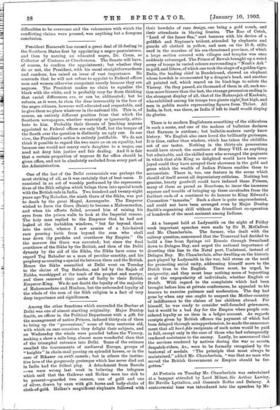One of the last of the Delhi ceremonials was perhaps
the most striking of all, as it was certainly that of best omen. It consisted in an act of worship performed by the representa- tives of the Sikh religion which brings them into special touch with the British rule in India. Two hundred and twenty-eight years ago Teg Bahadur, the ninth Guru of the Sikhs, was put to death by the great Mogul, Aurungzebe. The Emperor wished to force the Guru (Saint) to become a Mahommedan, and when his efforts failed, accused him of raising his eyes from the prison walls to look at the Imperial zenana. The holy man replied to the Emperor that he had not looked at the forbidden windows, " but far beyond them into the mist, whence I saw armies of a fair-haired race pouring forth from beyond the seas who shall tear down thy purdahs and overthrow thy Empire." On the morrow the Guru was executed; but since the final overthrow of the Sikhs by the British, and then of the Delhi dynasty by the aid of the Sikhs, the Sikhs have come to regard Teg Bahadur as a man of peculiar sanctity, and his prophecy as creating a special tie between them and the British. Hence the Sikhs assembled at Delhi went on Tuesday to the shrine of Teg Bahadur, and led by the Rajah of Nabha, worshipped at the tomb of the prophet and martyr, and there renewed their oaths of fealty to their British Emperor-King. We do not doubt the loyalty of the majority of Mahommedans and Hindoos, but the unbounded loyalty of the whole of the men of the Sikh religion is a fact of very deep importance and significance.






































 Previous page
Previous page